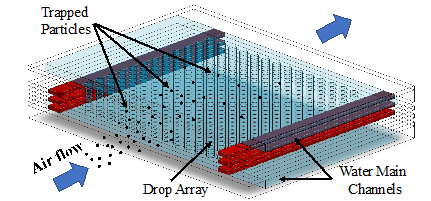
Schematic view of the liquid membrane filter, showing multiple layers of liquid columns. Each layer contains liquid columns between two parallel plates
Invention Summary:
Separation and filtration devices have been widely used in numerous applications. Deterministic lateral displacement (DLD) systems are designed to separate biological samples and particulates of different sizes by forcing them through a periodic lattice of obstacles. DLD systems have been utilized to separate blood cells, circulating tumor cells and nanoscale particles. All obstacle lattices used in known DLD systems are exclusively solid based, which may lead to clogging during operation and are costly to fabricate.
Rutgers researchers have designed and developed a new generation of separation and filtration devices utilizing anchored-liquid arrays as fluid-based membranes and stationary phases. In operation, these anchored-liquid arrays, when submerged in an immiscible continuous phase, can provide separation and filtration of suspended cells or particulates.
Market Applications:
- Microfluidic DLD devices
- Filtration of airborne particulate matter
- Removal of oil contamination from water
Advantages:
- Reusable
- Low-cost
- Scalable
- Customizable – anchored-liquid array can be rearranged for higher performance efficiency according to specific applications
- Physical property of the anchored-liquid column can be utilized to enhance performance
Intellectual Property & Development Status:
Patent pending. Available for licensing and/or research collaboration.